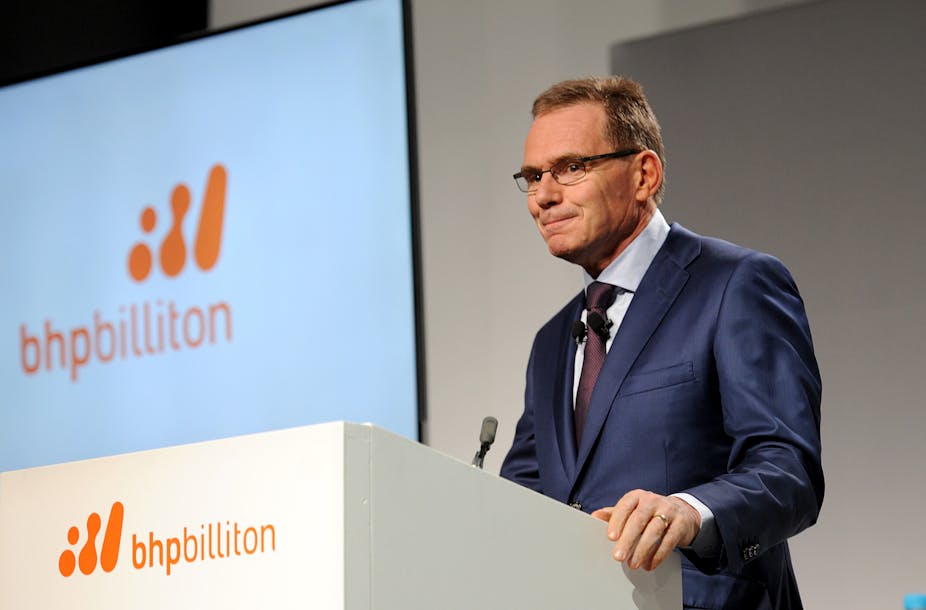During the commodity price boom from 2004-2011 BHP Billiton’s board raised the firm’s dividend to an unsustainable level. Now, in the commodity bust, the board has been forced to cut it by 75%.
The board has been heavily criticised for its conduct of dividend policy. Critics have focused mainly on the type of dividend policy and timing of dividend changes. But that misses the big picture in a cycle of boom and bust.
The performance of BHP’s board and its management should be measured by the amount of shareholder value created, after controlling for factors beyond their control. Was the windfall of cash generated in the mining boom either invested wisely or paid out to shareholders, or was it wasted on bad investment and value-destroying acquisitions? The latter has been the historical normal for global resource companies through resource boom and bust cycles.
The windfall
BHP’s operating cash flows grew from US$5 billion in 2004 to US$30 billion in 2011. BHP’s board responded by increasing dividends nearly sixfold, from 9.5 to 55 US cents per share in just the seven years from 2004 to 2011 (29% annual growth). In the following four years dividends grew only another 7 cents per share (3% annual growth).
After 2011 the price of all of BHP’s commodities fell – first slowly and then quickly. Cash flow shrank to the point that BHP’s board was forced to choose between its “progressive” dividend policy and its “A” credit rating. The credit rating prevailed.
Before being too critical of the BHP board for not implementing its own dividend policy, we should consider the whole picture of how BHP used its cash flows in the 2004-2011 period.
What does this table above tell us about BHP’s management of its cash flows?
Debt reduction, share buybacks, dividends: US$25 billion of the windfall of cash was used for debt reduction. Another US$44 billion was returned to shareholders in the form of share buybacks (US$22 billion) and dividends (US$22 billion) – a total of US$69 billion. Thank goodness for that.
Acquisitions: BHP spent “only” US$11 billion of its cash flows on acquisitions in this period: US$6 billion on Western Mining in 2005 and US$5 billion on the Fayetteville gas assets. Another US$15 billion was spent on the Petrohawk gas assets only days after the end of this period.
Unfortunately, the first half earnings announcement included a write-down of the US gas assets by US$7.2 billion. But criticism of the purchase of those assets relies mainly on the advantage of hindsight.
Nonetheless, it is by good luck rather than good management that more was not wasted on expensive acquisitions – especially in BHP’s failed bid for Rio Tinto when then CEO Marius Kloppers offered to pay at least US$20 billion over the odds for Rio. This assessment does not rely on hindsight. It is based on the increase in the BHP share price and decline in Rio Tinto’s share price at the time the BHP bid was withdrawn.
Capital expenditure: BHP spent the largest part of its extra cash flow on expanding production. There is always a danger that firms that receive cash windfalls will waste the cash on low-return investment projects. For the most part BHP has not done that in this cycle – although the plans for the US$20 billion expansion of the harbour in Port Hedland were a very worrying sign.
After considering how BHP’s windfall of cash flow was used in the boom period of 2004-2011, is it right to criticise the BHP board for paying out a large amount of cash as dividends, even if that made dividends unsustainable?
The verdict
The board might have made greater use of buybacks, especially to buy back more shares in London where BHP shares traded at a large discount to the same share on the ASX. It might also have declared “special dividends”, but that would have signalled they did not believe the cash flows were permanent.
But those considerations about how cash should be paid out of the firm are not the first-order issue when an unanticipated surge of cash flows occurs. The total volume of cash paid out is what shareholders should focus on. BHP’s board should be applauded for raising dividends during the boom. That proved unsustainable, but so what?
Overall, BHP’s board has done a reasonably good job of not squandering the proceeds of the mining boom. The fact that its dividend policy proved unsustainable is simply not the main issue.

